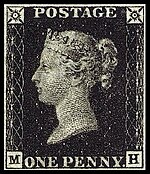 The Penny Black was the world's first adhesive postage stamp used in a public postal system. It was issued in Britain on 1 May 1840, for official use from 6 May of that year.
The Penny Black was the world's first adhesive postage stamp used in a public postal system. It was issued in Britain on 1 May 1840, for official use from 6 May of that year.All London post offices received official issues of the new stamps but other offices throughout the United Kingdom did not, continuing to accept postage payments in cash only for a period. Post offices such as those in Bath began offering the stamp unofficially after 2 May.
The idea of an adhesive stamp to indicate pre-payment of postage was part of Sir Rowland Hill's 1837 proposals to reform the British postal system; it was normal then for the recipient to pay postage on delivery. A companion idea, which Hill disclosed on 13 February 1837 at a government enquiry, was that of a separate sheet that folded to form an enclosure or envelope for carrying letters. At that time postage was charged by the sheet and on the distance travelled.
Postal delivery systems using what may have been adhesive stamps existed before the Penny Black. Apparently the idea had at least been suggested earlier in Austria, Sweden, and possibly Greece.
The stamps were printed in unperforated sheets, to be cut with scissors for sale and use.
An original printing press for the Penny Black, the D cylinder press invented by Jacob Perkins and patented in 1819, is on display at the British Libraryin London.
Joseph Addison was born this day. He was an English essayist, poet, playwright and politician. He was the eldest son of reverend Lancelot Addison. His name is usually remembered alongside that of his long-standing friend, Richard Steele, with whom he founded The Spectator magazine.
ReplyDelete